KTM Adventure: 1090R vs 1190R
KTM hit the adventure bike market hard in 2013 with the release of the 1190 Adventure, their crosshairs aimed directly at the large-displacement ADV bikes such as the BMW R1200GS. Now, after just a few years in production, KTM has decided to go a different route. The 1190 is not being offered for the 2017 model year; instead, it’s been replaced by two separate models, the 1090 Adventure, and the mighty 1290 Adventure. Let’s take a look at how the 1090 stacks up….
At a glance, it’s easy to draw the conclusion that this change is simply a marketing ploy. However, it’s a product of R&D in response to customer feedback.
To fully understand the motive, we need to take a step back in time to examine the way KTM decided to roost their way into the big-displacement ADV bike market in the first place. When KTM entered the multi-cylinder adventure bike mashup in ’03, they did so with the 950 Adventure. An uncompromising, terrain-tearing, beast of a motorcycle with close family ties to the Rally 950, it was the bike Fabrizio Meoni used to take first place during the 2002 edition of the legendary Dakar Rally.
After the 950 Adventure, the 990 Adventure was introduced in 2006 (2007 in the U.S.). The 990 was essentially the same as a 950 Adventure aside from a few updates, most notably, a Keihin fuel injection system and, as the name suggests, a slight increase in engine displacement. These alterations made the bike even more performance-oriented.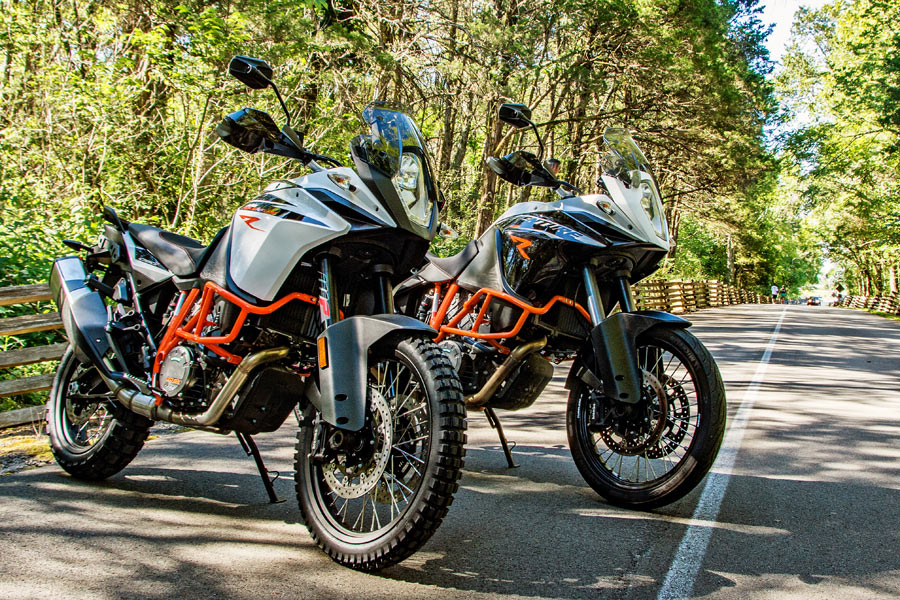 The 1190R is a fantastic machine with gobs of power on tap. It certainly outperforms its descendant in terms of horsepower; however, the 1090R is a more well-rounded machine for the rider planning to do more off-road work.
The 1190R is a fantastic machine with gobs of power on tap. It certainly outperforms its descendant in terms of horsepower; however, the 1090R is a more well-rounded machine for the rider planning to do more off-road work.
KTM was obviously catering to the more dedicated off-the-asphalt riders at the time. When compared to the other big ADV bike offerings, KTMs were much more spartan in nature, with almost no equipment not there simply to make the bike run. Standard 990s were equipped with an ABS system but that was about the only creature comfort you got.
The 950 and 990 Adventures are essentially big dirt bikes and they beg to be ridden as such. So, in 2013, when the 1190 Adventure was introduced, with its sophisticated electronics package and its relative increase in complexity compared to the older KTM Adventure models, riders who loved their older bikes for their spartan qualities were not particularly sold on the “newfangled” model. In addition, the 1190’s MSRP was substantially higher than that of previous models.
KTM didn’t want to abandon the customers who prefer an adventure bike that’s heavily biased toward going off the beaten path. Enter the 1090 Adventure R, KTM’s answer to the folks who felt left behind when the 1190 came out, and priced closer to what the 990 Adventure was listed when it was released. Admittedly, the 1090 still sits a bit like an F-18 next to a P-51 when compared to the old 950 ADV, but in today’s world of increasingly stringent emissions standards and steadily evolving standards for what should come standard on motorbikes, like it or not, the electronics are here to stay.
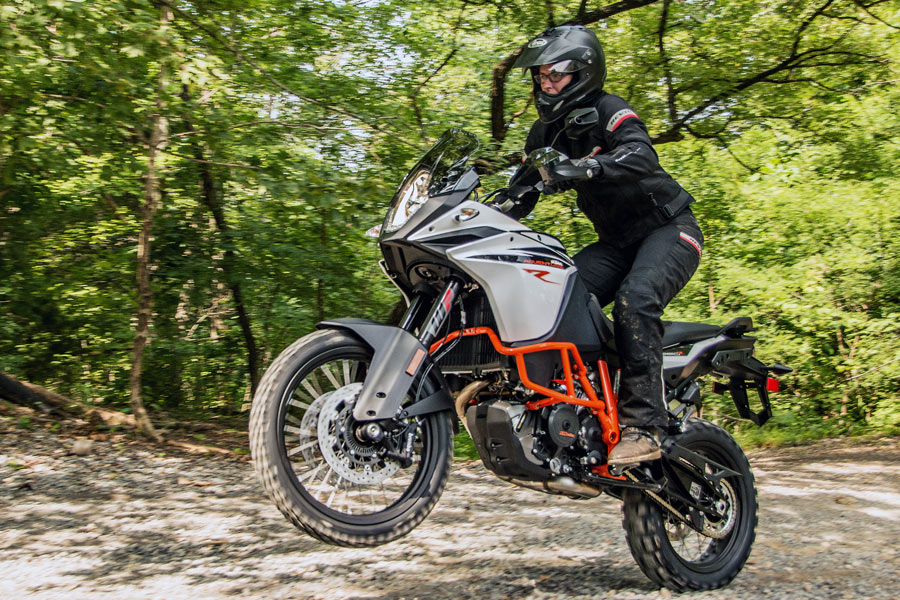 Not only does the 1090R feel more agile than the 1190R when the pavement ends, it feels more agile than the current line of 800cc ADV bikes.
Not only does the 1090R feel more agile than the 1190R when the pavement ends, it feels more agile than the current line of 800cc ADV bikes.
While some will see this as a downside, the reality is that these computer systems help to keep those of us who are not quite on Chris Birch’s level happily stuck to the seat and headed in the proper direction on the nearly 125-horsepower 1090. Seasoned off-roaders will be the first to tell you that more power is not always the answer. Unless you are very experienced, a more powerful bike will just get you into situations you’re not equipped to get out of.
Unfortunately, many will believe that the 1090 Adventure is simply a stripped-down version of the 1190, built only to compete with the Japanese adventure bikes, and that you’d be far better served with a used 1190R. While yes, the 1090, and almost every other vehicle for that matter, is built to fit neatly into a competitive position in a market, it’s certainly more than a budget 1190R.
• Suspension and Engine Differences
The 1090’s engine is actually a 1050cc engine, not to be confused with the engine in the 1050 Adventure that’s also being discontinued with the introduction of the 1190R . The version of the LC8 engine that’s in the 1090 Adventure is completely revised, with an increase in compression ratio to 13:1 versus the 1190’s 12.5:1, a new crankshaft, connecting rods, pistons, cylinder heads, balancing shaft, a heavier flywheel, revised velocity stacks, and improved fuel injection mapping. These changes to the engine help make the bike feel lighter and more responsive to rider input than the 1190 due to the reduced reciprocating mass of the engine components.
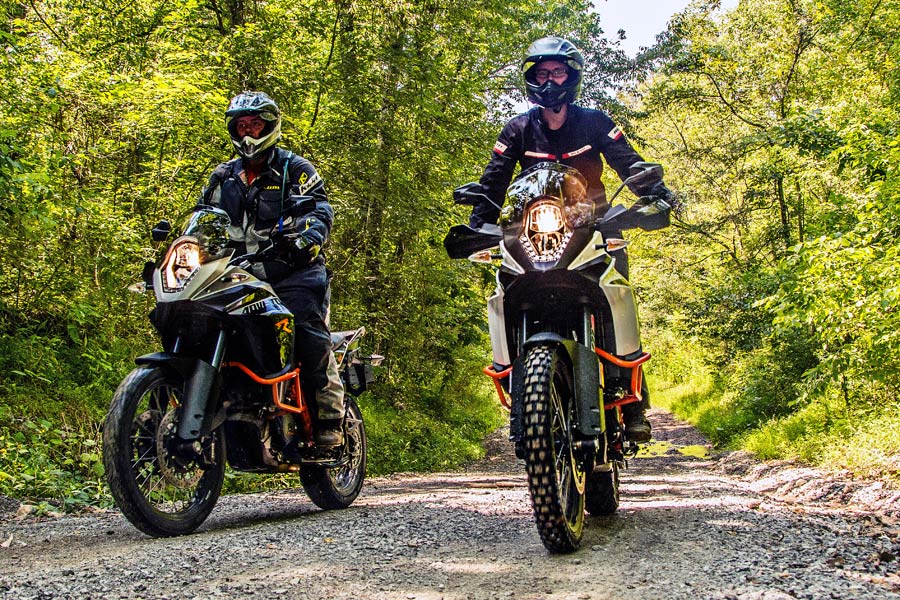 Although these machines are similar, the changes KTM made to the 1090R make it a completely different bike to ride.
Although these machines are similar, the changes KTM made to the 1090R make it a completely different bike to ride.
Also, thanks to the heavier crank and flywheel as well as the shorter stroke and smaller bore than the 1190 (103mm x 63mm vs. 105mm x 69mm), the 1090 won’t stall as easily and will feel less clunky when the engine is loping around at very low revs. These revisions, combined with the refined FI mapping, ensure tractable power that comes on predictably and smoothly from very low revs.
The 1090R, like the 1190, comes standard with a slipper clutch, another engine component that will help to keep the big twin under control and headed in the intended direction. The decrease in displacement and increase in compression ratio combined with the mapping changes mean the 1090 achieves a higher MPG than the 1190.
The engine isn’t the only thing that’s new for the 1090R, the suspension has been updated as well. The suspension travel is the same as the 1190R but the 1090R is equipped with stiffer 6.5 Nm springs compared to the 5.5 Nm springs that came in the 1190. In addition, the fork valving has been updated for the 1090R. The 1090R also comes with a PDS shock absorber; PDS stands for “Progressive Damping System” and has been used on KTM’s EX-C line for years. PDS allows for a plush ride over small bumps and small obstacles but in the bottom of the stroke the damping is significantly increased to help keep the bike from bottoming on the rough stuff. It also helps to keep the bike in check when riding hard through G-outs or over jumps. This doesn’t mean the suspension can’t be bottomed but when it occurs it’ll do so in a more controlled manner. As usual, the WP suspension is fully adjustable with regard to preload, compression, and rebound.
The suspension and engine upgrades mean the 1090R will have a significantly better feel off road, feel substantially lighter, and handle noticeably better than the 1190R even though the 1090 is only slightly lighter.
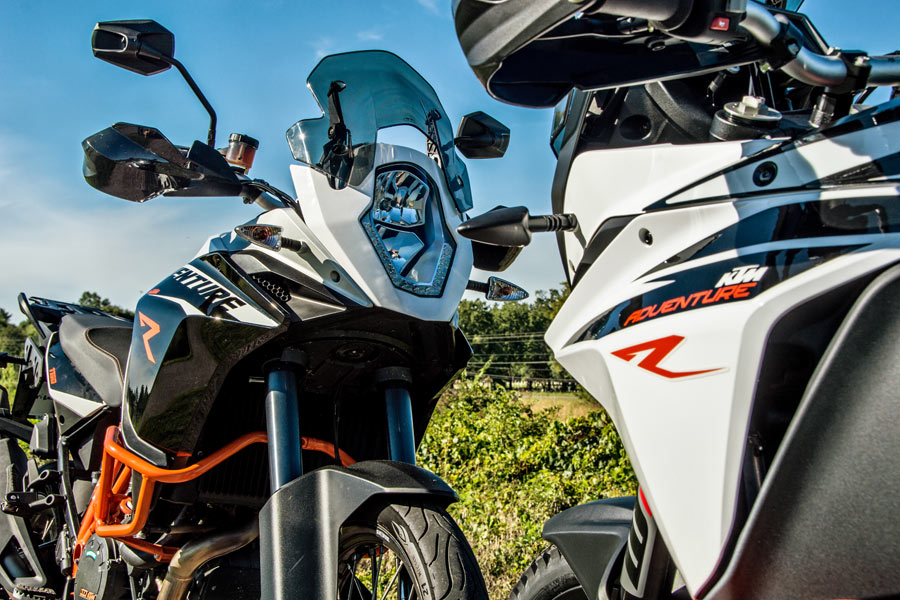
Now, what you give up on the 1090R compared to the 1190: Perhaps the biggest sacrifice is that the 1090R does not come equipped with a center stand from the factory. Anyone who has had to change a tube, patch a tire, adjust a chain, or even just lube a chain while out on the road knows that these tasks are much easier and much quicker with a center stand. A center stand is available for purchase for the 1090 if you decide you need one. As previously mentioned, the 1090 puts out nearly 125 hp compared to the 1190 which approaches 150 hp and, while the torque figures are lower on the 1090, it’s not by much. The 1190 has a claimed torque value of 92 lb.-ft. while the 1090 cranks out a less than measly 80 lb.-ft. The 1090R, like the 1190R, still has four different driving modes, Off-Road, Rain, Street, and Sport. It still has traction control and switchable anti-lock brakes but, to help keep the price down, it does not have the lean angle-dependent cornering ABS that the 1190 had.
• Electronics, Power and Performance
The driving modes still function as they did on the 1190; Off-Road mode cuts the power to 100 horsepower and the ABS system will allow the rear wheel to lock to aid in getting around tight corners. Off-Road mode also dials back the intervention from the traction control system which allows the rear wheel to step out in a controlled manner for the same reason, and of course, because it’s fun!
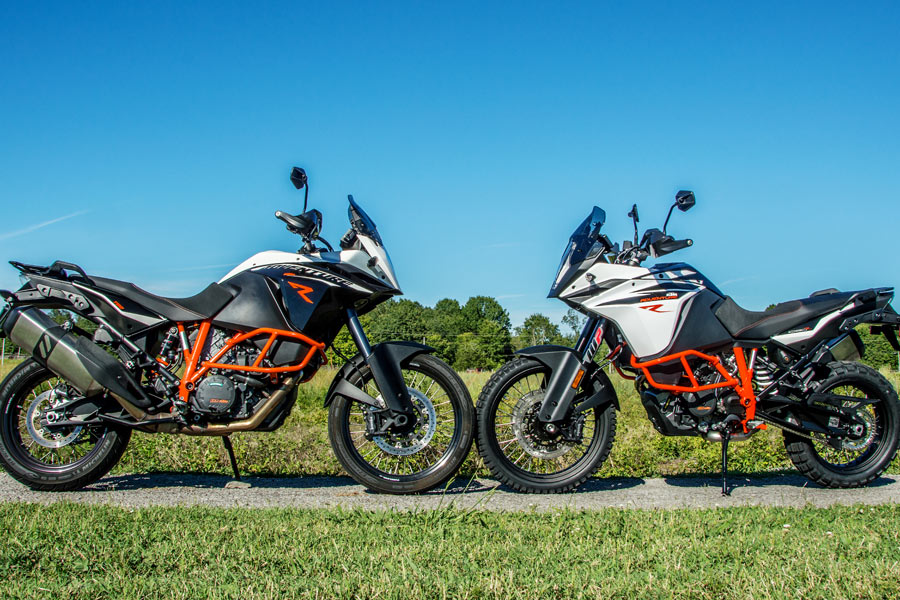 I’m happy to see the trend of heavier, more powerful, more gadgets, and more expensive go its own way. That sort of bike obviously has a market, but it’s good to see companies offering more off-road biased machines.
I’m happy to see the trend of heavier, more powerful, more gadgets, and more expensive go its own way. That sort of bike obviously has a market, but it’s good to see companies offering more off-road biased machines.
| KTM 1090 ADVENTURE R SPECS |
| Configuration: 4-cycle, 75° radial twin |
| Displacement: 1050cc |
| Bore: 103mm |
| Stroke: 63mm |
| Power(HP): 92 kW (~123.4 hp) |
| Starter: Electric Starter |
| Lubrication: Forced oil lubrication (3 pumps) |
| Transmission: Six-speed manual |
| Cooling: Liquid cooling |
| Clutch: Hydraulically actuated slipper clutch |
| EMS: Keihin EMS with twin ignition |
| Frame: Powder coated Chromium-Molybdenum steel trellis frame |
| Front Suspension: WP 48mm forks |
| Rear Suspension: WP-PDS Mono-shock |
| Suspension Travel: Front—220mm, Rear—220mm (~8.6 in.) |
| Front Brake: Fixed four-piston Brembo radial calipers with floating disk brake (x2) |
| Rear Brake: Fixed twin-piston Brembo caliper with disk brake |
| Brake Disk Diameter: Front—320mm, Rear—267mm |
| ABS: Bosch 9M+ Two-channel ABS |
| Steering Head Angle: 64° |
| Wheelbase: 1580 ±15mm |
| Ground Clearance: 250mm (~9.8 in.) |
| Seat Height: 890mm (~35 in.) |
| Fuel Tank Capacity: 23 l (~6.1 gal.) |
| Dry Weight: 207kg (~456 lb.) |
Street mode delivers all 125 horses but with reduced kick compared to Sport mode. These modes are usable off road as well if you’re keen to roost your buddies or if you have the skill to really hang the back end out in an epic power slide. Just remember to switch off the traction control or the street traction control mapping will be utilized.
There are a few parts available from KTM that are necessary, in my opinion. First, oversized foot pegs. Second, a decent bash plate, and third, the dongle that retains your ECU settings when you switch the bike off. The 1090R also doesn’t come with tire pressure monitoring sensors or a linked braking system but it is equipped with some electronics that the 1190 Adventure wasn’t, KTM’s ATIR system.
ATIR stands for “Automatic Turn Indicator Reset” and as the name suggests, it’s a system that cancels the turn signals after 10 seconds of forward movement or 150 meters. This is a safety feature I can get behind, as someone who leads/chases lots of rides, I don’t know how many miles I’ve ridden while watching another rider’s indicator flashing away.
Rideability is easy to overlook during the quest for the tallest suspension and the most powerful engine. KTM has been in the business of making high performance machines for quite some time and they produce some of the most charismatic machines on the market. KTM engineers intimately understand how relatively small differences in an engine’s power delivery or a chassis’ handling characteristics can completely change the dynamic of a machine.
• Summary
The 1090 is not around to make compromises; it’s certainly friendlier than the 990 ever was but it’s nice to see that KTM has started making motorbikes that are accessible on many skill levels by many riders. The previous big twins were very powerful and equipped with lightweight engine internals. This ensured they were quick to find RPMs and subsequently high power; most of us mere mortals would be up an Amazon-sized stream of proverbial excrement before we knew what hit us without the aid of the electronic nanny dialing back the power output. This is not to say that the 1090 Adventure is underpowered or boring, just more accessible, and definitely better off the pavement.
The KTM engineers earned their check on this project, ultimately the 1090R sacrifices very little in order to shed weight, gain off-road capability, improve rideability, and reduce the price of this motorbike. MSRP: $14,699 KTM.com
 Caleb McIntuff (Doktor Orange) is an engineer, mechanic, photojournalist, riding instructor, and lover of all things technical. An insatiable thirst for knowledge keeps Caleb constantly learning. When he isn’t scheming in the shop, he can be found riding alongside his wife, Marisa, as they embark on various adventures astride their mighty KTMs. MotoDuoAdventures.com
Caleb McIntuff (Doktor Orange) is an engineer, mechanic, photojournalist, riding instructor, and lover of all things technical. An insatiable thirst for knowledge keeps Caleb constantly learning. When he isn’t scheming in the shop, he can be found riding alongside his wife, Marisa, as they embark on various adventures astride their mighty KTMs. MotoDuoAdventures.com
https://adventuremotorcycle.com/bikes/ktm-1090r-vs-1190r-adventure-review#sigProId10a9f8cd09




